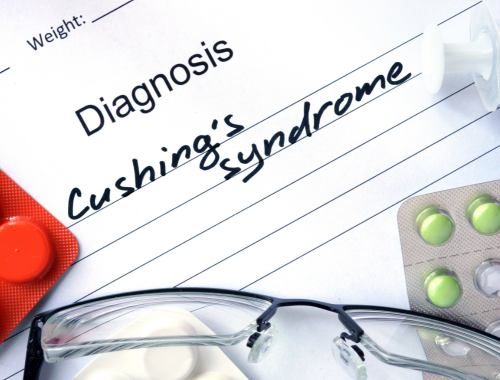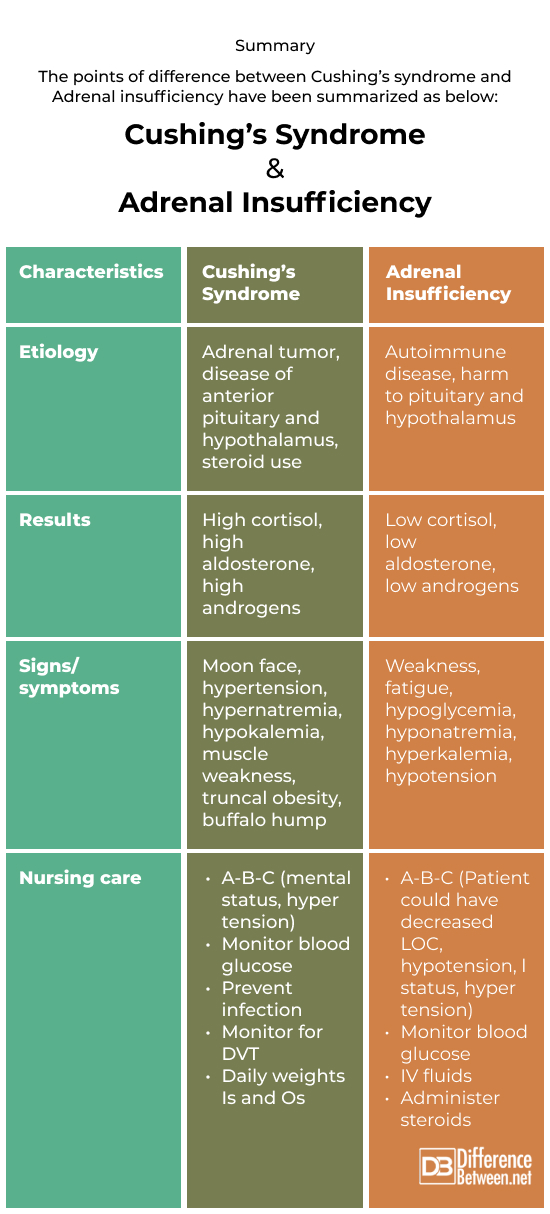Difference Between Cushing’s Syndrome vs. Addison’s Disease

What is Cushing’s syndrome vs. Addison’s disease?
An overproduction of cortisol by the adrenal glands (also known as suprarenal glands, which are small, triangular-shaped glands) can also cause this condition. It is most commonly linked with lengthy exposure to high cortisol levels.
The adrenal gland is damaged in Addison’s disease (also termed as hypocortisolism). It is also called as adrenal insufficiency and not enough cortisol and aldosterone is produced.

Similarity
Addison’s disease and Cushing’s syndrome are both related to malfunctioning adrenal glands and can be seen as two sides of the same issue.
Cushing’s syndrome
Cushing syndrome (hypercortisolism) can be caused by abnormally high levels of the hormone cortisol. The excess hormone may be due to certain drugs or medicines or because the body releases too much of it. The condition is treatable and the treatments does last for some time. Symptoms include thinning skin and excessive weight gain.
Addison’s disease
A rare illness called Addison’s disease (hypocortisolism), also termed as adrenal insufficiency, occurs when the adrenal glands produce low amounts of cortisol or aldosterone. It is well known that the adrenal glands occasionally fail to produce enough aldosterone and cortisol. When the body is under stress, a cortisol deficit can cause a life-threatening Addisonian crisis, which is characterized by low blood pressure. Symptoms are non-specific and include weariness, nausea, skin discoloration, and dizziness upon standing. Taking hormones to replace those that the adrenal glands don’t generate is part of the treatment.
Difference between Cushing’s syndrome vs. Addison’s disease?
Definition
Cushing’s syndrome
It is caused by high cortisol production.
Addison’s disease
It is caused by low cortisol production. This lack of cortisol can cause an Addisonian crisis, which is characterized by low blood pressure, when the body is under stress (such as when fighting an infection). Fatigue, nausea, skin discoloration, and dizziness upon standing are non-specific symptoms. Taking hormones to replace those that the adrenal glands are unable to make is part of the treatment.
Symptoms
Cushing’s syndrome
- Fatigue
- Flushes
- High BP
- Anxiety
- Weight gain
- Moon face
- Abdominal obesity
- Skin that bruises easily
- Blurry vision
- Stunted growth in children
Addison’s disease
- Mild depression
- Abdominal pain
- Muscle weakness
- Salty items craving
- Irritation
- Tiredness
- Too much thirst
- Water-electrolyte imbalance
- Loss of appetite
- Darkening of skin
Treatment
Cushing’s syndrome
- Medication such as ketoconazole
- Chemotherapy
- Surgery
- Radiation
- Reduced steroids
Addison’s disease
- Corticosteroid (steroid) replacement therapy for life
- IVF with glucocorticoids
Causes
Cushing’s syndrome
- Use of glucocorticoid medications
- Pituitary tumors
- Adrenal cortical tumors
- Lung, pancreas, thyroid and thymus tumors
Addison’s disease
- Damage to the adrenal glands
- An autoimmune response
- Impaired Steroidogenesis
- Adrenal destruction
Diagnosis
Cushing’s syndrome
Dexamethasone suppression test – to differentiate between pituitary and adrenal tumor.
Addison’s disease
Adrenocorticotropic Hormone Test – differentiates between primary and secondary Addison
Summary
The points of difference between Cushing’s syndrome and Adrenal insufficiency have been summarized as below:

FAQ
What is the difference between Cushing’s syndrome and adrenal insufficiency?
A deficiency of adrenal hormones, mainly glucocorticoids (cholesterol-derived steroid hormones synthesized and released by the adrenal gland) and mineralocorticoids (a class of steroid hormones that influence salt and water balance), is known as adrenal insufficiency. Cushing syndrome is an uncommon condition associated with persistently excessively high cortisol levels.
How are Addison’s disease and Cushing’s syndrome similar?
Addison’s disease and Cushing’s syndrome are both related to malfunctioning adrenal glands and can be seen as two sides of the same issue.
How do you differentiate between adrenal and pituitary Cushing’s?
Cushing’s syndrome occurs due to the excessive and continuous production of the hormone cortisol, which is a crucial glucocorticoid hormone. In approximately 15% of cases, the growth of a tumor on either of the two adrenal glands can lead to the development of this condition. These tumors, which can either be benign or malignant, release cortisol into the bloodstream.
In Pituitary Cushing’s disease, the pituitary gland (also known as hypophysis) is a small, pea-sized gland) secretes excess adrenocorticotropic hormone (ACTH).
How to differentiate between Cushing syndrome and Cushing disease?
Cushing disease (results due to elevated levels of a hormone called cortisol) is a condition that arises when a pituitary tumor (unusual growths that develop in the pituitary gland) produces Adrenocorticotropic hormone (ACTH), leading to Cushing syndrome. Cushing syndrome is characterized by an excess of cortisol (a steroid hormone) in the body, which causes a range of symptoms.
How do you test for Addison’s or Cushing’s?
An Addison’s disease blood test measures sodium, potassium and cortisol levels in the body. If the concentrations of this elements are found low, that may signal Addison’s.
A doctor can diagnose Cushing’s syndrome with High-dose dexamethasone suppression test, urine test, saliva examination, or a blood test. Sometimes, a follow-up test is needed to identify whether excess cortisol is the result of Cushing’s syndrome or a different condition.
Are Cushing’s and Addison’s disease basically opposites?
Yes, they are basically opposites. In Addison’s disease, your body has low cortisol percentage (and aldosterone), while in Cushing’s syndrome, you have excessive cortisol (hypercortisolism).
- Difference Between Global Warming and Greenhouse Effect - May 18, 2024
- Difference Between Vaccination and Immunization - March 3, 2024
- Difference Between Selective Mutism and Autism - February 25, 2024
Search DifferenceBetween.net :
Leave a Response
References :
[0]Boscaro, M., Barzon, L., Fallo, F., & Sonino, N. (2001). Cushing's syndrome. The Lancet, 357(9258), 783-791.
[1]Lacroix, A., Feelders, R. A., Stratakis, C. A., & Nieman, L. K. (2015). Cushing's syndrome. The lancet, 386(9996), 913-927.
[2]Nieman, L. K., & Turner, M. L. C. (2006). Addison's disease. Clinics in Dermatology, 24(4), 276-280.
[3]Sarkar, S. B., Sarkar, S., Ghosh, S., & Bandyopadhyay, S. (2012). Addison's disease. Contemporary clinical dentistry, 3(4), 484.
